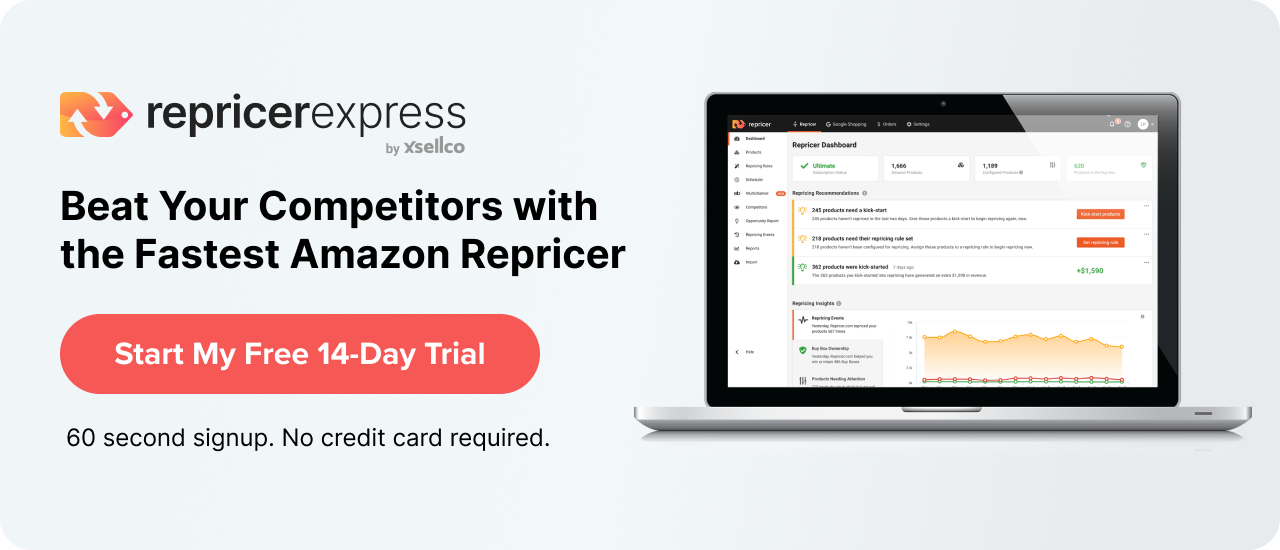It sounds almost crazy to suggest that starting an Amazon FBA business with less than $1,000 is possible. After all, wouldn’t it cost a lot more when you factor in buying products from manufacturers or suppliers, registering for legal and tax contracts, creating a brand, developing an advertising and marketing strategy, paying Amazon fees, storing and shipping items, and so much more? Not necessarily, and RepricerExpress will show you how to get started on a budget.
Because Your Margin of Error is Really Small, Spend a LOT of Time Researching and Learning
Ever wonder how it is that rich people can seem to grow their money so much easier and quicker than the average person? It’s not that they have more of it (but that certainly helps), it’s that they have more room for failure. After all, if one venture doesn’t work out, there’s enough money to spread around in other ventures, increasing the chances one of them will succeed.
Starting an Amazon business with less than $2,000 means you don’t get that ample margin of error, so you’ll have to be far smarter, methodical and selective from the get-go.
For example, you might want to restrict your sales to within your country until you can grow more capital and afford to ship overseas. But what if one of the suppliers on your shortlist is based in another country, affording you the opportunity to ship to an Amazon fulfillment centre there? It might mean more complex dealings, but it could also mean higher sales and profits, too.
You’ll Have to be Quite Selective About Your Inventory
There are millions and millions of products on Amazon, but only a small portion of that will fit your small-budget needs. Although it might seem like an unnecessary extra, paying for a tool like Jungle Scout can bring a higher return on investment than if you went at it alone. That’s because it can give you valuable and time-saving information when you narrow down your list of profitable items to sell on Amazon.
One tool that’s pleasantly free is the FBA Revenue Calculator, which you should absolutely be using on every product idea before investing in it. It gives you a fairly accurate idea of the revenue you can expect to make, but be sure to pad your expectations by inputting the highest cost price you see private label sellers listing it for.
When looking for products, here’s a solid list you should be referring to at all times:
- Size: If it can fit into a shoebox or something smaller and is fairly light in weight, you’re going to be able to minimize your shipping costs.
- Seasonality: It’s highly risky to start an Amazon business with a budget of $2,000 with seasonal items, so stick to products that are bought evenly throughout the year.
- Usability: The more often or regularly a product is used, the higher demand there is and the better your chances of success are. Avoid niche or one-and-done items.
- Risk: Stick to products that transport well and can handle a tiny bit of rough-handling, and avoid fragile or breakable items. There’s a market for that, but this isn’t the spot for it.
- Brands: The big-name brands are huge sellers, but you’ll have an incredibly tough time making a go of it. Not only would you have to contend with strict branding and selling regulations, but you’ll also be facing stiff competition.
- Category: Some categories are far more competitive than others, like electronics. Although the wholesale product price can be low, you’ll need to spend in other areas to set yourself apart. Almost impossible on a budget of $2,000.
With this in mind, scour the internet with an open and creative mind and jot down every product idea you think of, no matter how outlandish or unrealistic it might seem at the time. The idea is to get a huge pool of choices that you can winnow down to a usable shortlist.
Check Prices on Alibaba
From there, cross-reference prices on Amazon with the same product price on Alibaba. This will give you a solid idea of the potential profit margins of each item. Then, multiply the Alibaba price by the number of items you’ll want in your inventory, like 250-500, to see how many purchases your budget will allow for.
When you’ve settled on a list of potentially inexpensive but profitable items, order samples of them, whether from Alibaba or another supplier. Make sure to ask about minimum order quantities (especially on Alibaba), negotiate for smaller quantities that fit your budget, and stand your ground when your needs can’t be met. It’s just business, for both sides.
When dealing with suppliers, you’ll want them to give you, a small seller, the time of day, so be on the ball with your interactions. Have a business plan in place that outlines how many products you’ll want to order after testing the samples, backed up by the research you did on sales and profit projections for the following year.
In terms of paying your suppliers (particularly for small orders), PayPal is an excellent option. It might not be sustainable over the long-term because of its fees, but for security and easy/quick transactions, it’s hard to beat.
Other Costs to Consider
Remember to leave room in your budget for paying for a professional Amazon account, Amazon fees, storage/packaging/shipping, legal needs, brand label and marketing/advertising. You might be budget-poor at this stage, but you should make up for it with time-richness.
With such a tight budget, speed is of the essence in terms of setting up and starting to sell. Don’t spend too much time on a fancy logo or special packaging — that can come later in the process as you refine things and compound sales.
For now, start by setting up building a social media presence, running promotions to hype visibility, assembling an email campaign to gather reviews, nailing down keywords and optimizing your listings. Also, make sure to really familiarize yourself with Amazon’s Terms and Conditions so you won’t run into tangles later on that could jeopardize your selling chances or even your account.
Once you start building some traction, one of the first areas you’ll want to reinvest in is more products. Placing orders with bigger quantities can help cut down on the per-product price, adding more to the profit column of your revenue. As you continue to build, you can diversify your reinvestments in other areas, like packaging, brand aesthetic, email marketing and more.
Final Thoughts
There are few guarantees in life, but one thing that’s about as close to a promise as you can get is RepricerExpress. Having a competitive product price has been shown time and again to have a strong influence on winning a Buy Box on Amazon, which can provide a huge and immediate boost in sales — something your small budget would really appreciate.
And because we know starting an Amazon business with just $2,000 isn’t easy, we’ll start you off with a free trial when you sign up now. Because hey, anything that can help get your Amazon business off to a roaring start is definitely something you should take a closer look at.
Related: 7 Amazon Product Selection Tips For 2020



